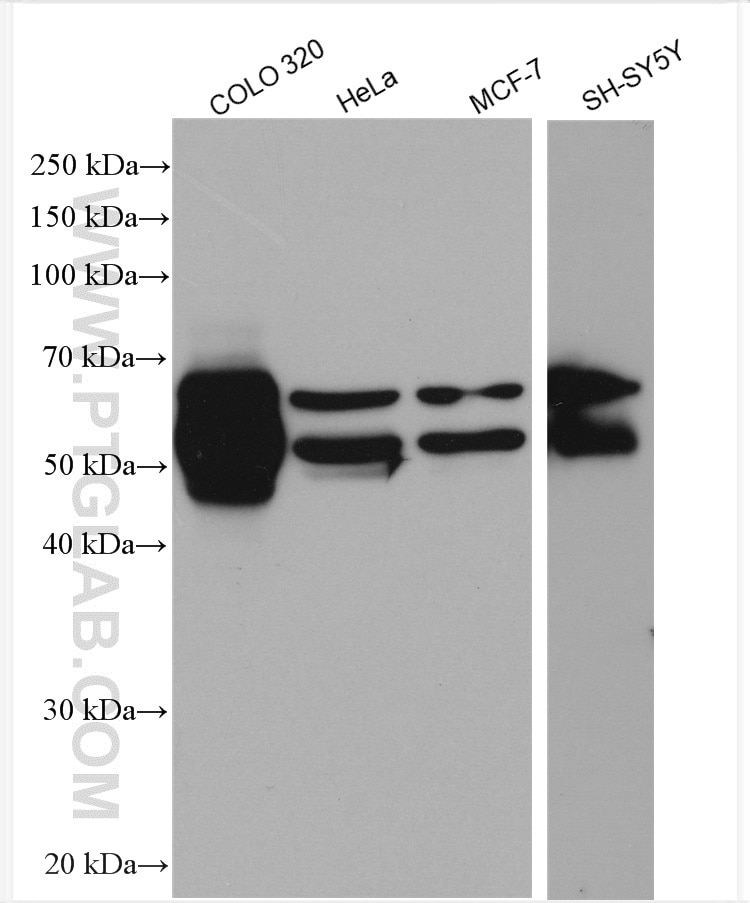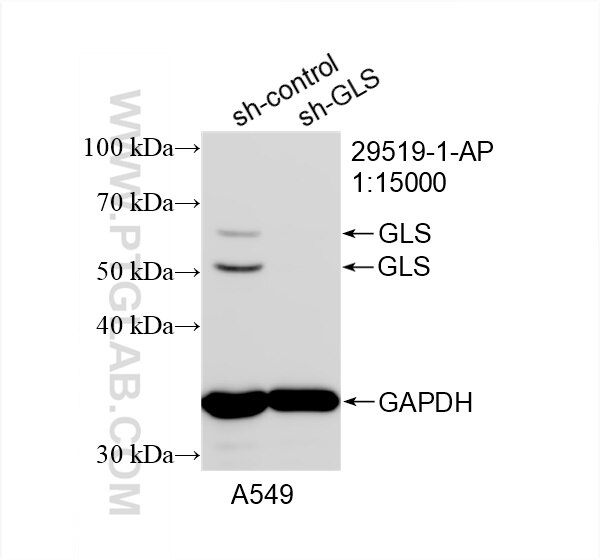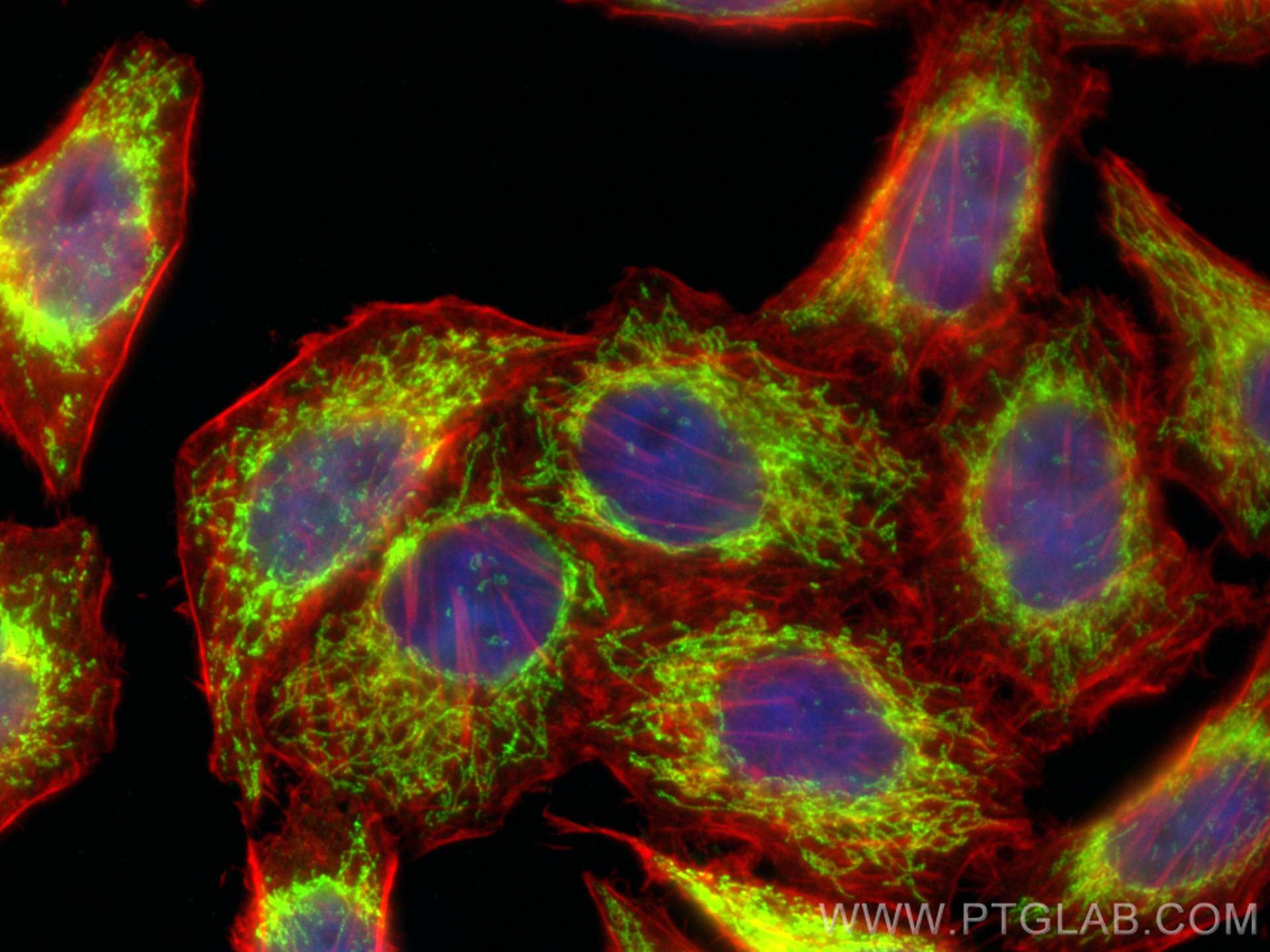Tested Applications
| Positive WB detected in | COLO 320 cells, A549 cells, Hela cells, MCF-7 cells, SH-SY5Y cells |
| Positive IF/ICC detected in | L02 cells |
Recommended dilution
| Application | Dilution |
|---|---|
| Western Blot (WB) | WB : 1:1000-1:6000 |
| Immunofluorescence (IF)/ICC | IF/ICC : 1:50-1:500 |
| It is recommended that this reagent should be titrated in each testing system to obtain optimal results. | |
| Sample-dependent, Check data in validation data gallery. | |
Published Applications
| WB | See 13 publications below |
| IHC | See 1 publications below |
| IF | See 1 publications below |
Product Information
29519-1-AP targets GLS in WB, IHC, IF/ICC, ELISA applications and shows reactivity with human samples.
| Tested Reactivity | human |
| Cited Reactivity | human, mouse, rat |
| Host / Isotype | Rabbit / IgG |
| Class | Polyclonal |
| Type | Antibody |
| Immunogen |
CatNo: Ag31167 Product name: Recombinant human GLS protein Source: e coli.-derived, PGEX-4T Tag: GST Domain: 1-140 aa of NM_014905 Sequence: MMRLRGSGMLRDLLLRSPAGVSATLRRAQPLVTLCRRPRGGGRPAAGPAAAARLHPWWGGGGWPAEPLARGLSSSPSEILQELGKGSTHPQPGVSPPAAPAAPGPKDGPGETDAFGNSEGKELVASGENKIKQGLLPSLE Predict reactive species |
| Full Name | glutaminase |
| Calculated Molecular Weight | 73 kDa |
| Observed Molecular Weight | 58 kDa, 65 kDa |
| GenBank Accession Number | NM_014905 |
| Gene Symbol | GLS |
| Gene ID (NCBI) | 2744 |
| RRID | AB_2918320 |
| Conjugate | Unconjugated |
| Form | Liquid |
| Purification Method | Antigen affinity purification |
| UNIPROT ID | O94925 |
| Storage Buffer | PBS with 0.02% sodium azide and 50% glycerol, pH 7.3. |
| Storage Conditions | Store at -20°C. Stable for one year after shipment. Aliquoting is unnecessary for -20oC storage. 20ul sizes contain 0.1% BSA. |
Background Information
GLS, also named as GLS1 and KIAA0838, belongs to the glutaminase family. It catalyzes the first reaction in the primary pathway for the renal catabolism of glutamine. Glutaminase-, glutamate-, and taurine-immunoreactive neurons develop neurofibrillary tangles in Alzheimer's disease(PMID:1672808).The glutaminase band in AA/C1 cells is more intense than in HT29 cells, in accordance with measurements of glutaminase activity, and had the same molecular mass of approx. 63 kDa. The bands for both cell lines are clearly different in size from both rat liver glutaminase (58 kDa) and rat kidney glutaminase (65 kDa)(PMID:12408749). It also reveals a molecular weight of 83-84 kDa as a phosphate-dependent glutaminase(PMID:447624;7512428). It has 3 isoforms named as KGA, GAM, GAC. This antibody can recognize KGA and GAC.
Protocols
| Product Specific Protocols | |
|---|---|
| IF protocol for GLS antibody 29519-1-AP | Download protocol |
| WB protocol for GLS antibody 29519-1-AP | Download protocol |
| Standard Protocols | |
|---|---|
| Click here to view our Standard Protocols |
Publications
| Species | Application | Title |
|---|---|---|
Cell Death Discov O-GlcNAcylation of glutaminase isoform KGA inhibits ferroptosis through activation of glutaminolysis in hepatoblastoma | ||
Front Oncol ITGB1-mediated molecular landscape and cuproptosis phenotype induced the worse prognosis in diffuse gastric cancer | ||
Cancer Metab Glutaminolysis is associated with mitochondrial pathway activation and can be therapeutically targeted in glioblastoma | ||
Cancer Lett YTHDF1 regulates GID8-mediated glutamine metabolism to promote colorectal cancer progression in a m6A-dependent manner | ||
J Ethnopharmacol Buyang Huanwu Decoction restores the balance of mitochondrial dynamics after cerebral ischemia-reperfusion through calcium overload reduction by the PKCε-Nampt-Sirt5 axis |








